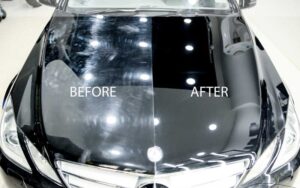Introduction:
Maintaining the beauty and shine of a black car can be quite a challenge. Every speck of dirt and every scratch seems to be magnified on its sleek surface. However, with the right techniques and products, you can achieve stunning results and keep your black car looking its best. In this blog post, we’ll delve into the insightful tips and tricks shared in a YouTube video titled “How to polish a BLACK car: techniques, tricks (and mistakes to avoid)!” by DIY detail experts Ivan and Nick.

Polishing Clear Coat, Not Paint:
One of the key takeaways from Ivan and Nick’s video is the understanding that when polishing a black car, you are actually polishing the clear coat, not the paint itself. The clear coat on a black car is no different from that on a white or silver car. This realization helps debunk the misconception that black cars require special treatment when it comes to polishing.
Keeping it Simple:
When approaching the task of polishing black paint, Ivan and Nick emphasize the importance of simplicity. They advise keeping the polishing pad as flat as possible and reducing speeds to prevent heat buildup. By avoiding excessive heat and swelling the paint, commonly referred to as the “Botox effect,” you can ensure a long-lasting and flawless finish. Buffer trails, often seen on cars that have been polished incorrectly, are a clear indication of improper rotary usage rather than a flaw of the rotary itself.
Pads and the Gold Standard Polish:
The choice of tools plays a crucial role in achieving exceptional results. Ivan and Nick recommend using a waffle pad, which effectively keeps the surface cool, cuts well, and provides a beautiful finish. They introduce their “gold standard” polish, a product they’ve developed with a focus on ease of use and outstanding performance. This polish offers a long working time, allowing you to work at your own pace without rushing. Additionally, its sprayable consistency ensures even distribution, minimizing wastage and eliminating the need to tape off the vehicle.
Proper Technique:
Starting with a lightly dampened pad, Ivan and Nick demonstrate their technique by polishing from the front and back, working their way towards the center. The DIY gold standard polish wipes off effortlessly, leaving behind a stunning, glossy finish. To minimize the risk of marring or scratching the paint, they suggest using a damp Rinseless Drying Towel for the initial wipe, followed by a dry towel to complete the process. It’s worth noting that when working with a repainted vehicle, extra caution should be exercised due to varying paint thickness.
The Joy of DIY Detailing:
Ivan and Nick highlight that the art of polishing a black car can be a fun and rewarding activity for people of all ages. Whether you’re polishing with your kids, grandparents, or friends, it’s an opportunity to bond and learn together. Their method provides impressive results while keeping the process accessible for anyone who wants to take pride in maintaining their vehicle’s appearance. It’s a chance to connect with loved ones, share knowledge, and enjoy the satisfaction of transforming your car’s aesthetics.
Conclusion:
Polishing a black car to achieve a stunning finish is well within the reach of every car owner. By following the techniques and tips shared by DIY detail experts Ivan and Nick, you can bring out the beauty, luster, and depth of your black car’s paintwork. Remember to approach the task with simplicity, choose the right pads and products, and enjoy the process of DIY detailing. With proper care and attention, your black car will continue to turn heads on the road, exuding a timeless elegance that commands attention.

